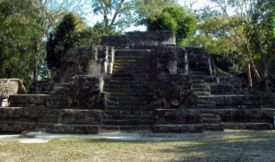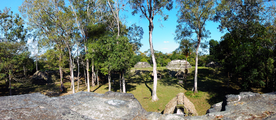
E-Group
Encyclopedia
E-Groups are unique architectural
complexes found among a number of ancient Maya
settlements. They are central components to the settlement organization of Maya sites and could have served as astronomical
observatories
. The alignment of these structural complexes corresponds to the sun
's solstice
s and equinox
es.

site of Uaxactun
, which was the first one documented by Mesoamerica
n archaeologists. http://www.doaks.org/ClassicMaya/maya05.pdf At Uaxactun, the Group E complex consists of a long terraced platform with three supra-structures arranged along a linear axis oriented north
-south
. The two smaller outlying structures flank the larger central temple. A stairway leads down to a plaza formed by Uaxacatun’s Pyramid E-VII. Three stele immediately front the E-Group, and a larger stele is located midway between Group E and Pyramid E-VII. Each of the four stairways incorporated into the complex (the main central one and three leading up to each supra-structure) bears two side mask
s (for a total of 16).
From a point of observation on Pyramid E-VII, the three structures have the following orientation:
period, indicative of the central role played by astronomical and administrative concerns in the very beginnings of Maya ceremonial construction and planning. The oldest documented E-Group is found at the Mirador Basin
site of Nakbé
.
Construction of E-groups continues on through the Classic period, with examples of these including the "Lost World Pyramid" at Tikal
in the Petén Basin
of northern Guatemala, and Structure 5C-2nd at Cerros
, in Belize
. Caracol
, also in Belize and the site that defeated Tikal during the Middle Classic
, has a large-scale E-Group located in the western portion of its central core.
Maya architecture
A unique and spectacular style, Maya architecture spans several thousands of years. Often the most dramatic and easily recognizable as Maya are the stepped pyramids from the Terminal Pre-classic period and beyond. Being based on the general Mesoamerican architectural traditions these pyramids...
complexes found among a number of ancient Maya
Maya civilization
The Maya is a Mesoamerican civilization, noted for the only known fully developed written language of the pre-Columbian Americas, as well as for its art, architecture, and mathematical and astronomical systems. Initially established during the Pre-Classic period The Maya is a Mesoamerican...
settlements. They are central components to the settlement organization of Maya sites and could have served as astronomical
Astronomy
Astronomy is a natural science that deals with the study of celestial objects and phenomena that originate outside the atmosphere of Earth...
observatories
Observatory
An observatory is a location used for observing terrestrial or celestial events. Astronomy, climatology/meteorology, geology, oceanography and volcanology are examples of disciplines for which observatories have been constructed...
. The alignment of these structural complexes corresponds to the sun
Sun
The Sun is the star at the center of the Solar System. It is almost perfectly spherical and consists of hot plasma interwoven with magnetic fields...
's solstice
Solstice
A solstice is an astronomical event that happens twice each year when the Sun's apparent position in the sky, as viewed from Earth, reaches its northernmost or southernmost extremes...
s and equinox
Equinox
An equinox occurs twice a year, when the tilt of the Earth's axis is inclined neither away from nor towards the Sun, the center of the Sun being in the same plane as the Earth's equator...
es.


Origin of the name
E-Groups are named after “Group E” at the Classic periodMesoamerican chronology
Mesoamerican chronology divides the history of pre-Columbian Mesoamerica into several periods: the Paleo-Indian , the Archaic , the Preclassic , the Classic , and the Postclassic...
site of Uaxactun
Uaxactun
Uaxactun is an ancient ruin of the Maya civilization, located in the Petén Basin region of the Maya lowlands, in the present-day department of Petén, Guatemala. The site lies some north of the major center of Tikal...
, which was the first one documented by Mesoamerica
Mesoamerica
Mesoamerica is a region and culture area in the Americas, extending approximately from central Mexico to Belize, Guatemala, El Salvador, Honduras, Nicaragua, and Costa Rica, within which a number of pre-Columbian societies flourished before the Spanish colonization of the Americas in the 15th and...
n archaeologists. http://www.doaks.org/ClassicMaya/maya05.pdf At Uaxactun, the Group E complex consists of a long terraced platform with three supra-structures arranged along a linear axis oriented north
North
North is a noun, adjective, or adverb indicating direction or geography.North is one of the four cardinal directions or compass points. It is the opposite of south and is perpendicular to east and west.By convention, the top side of a map is north....
-south
South
South is a noun, adjective, or adverb indicating direction or geography.South is one of the four cardinal directions or compass points. It is the opposite of north and is perpendicular to east and west.By convention, the bottom side of a map is south....
. The two smaller outlying structures flank the larger central temple. A stairway leads down to a plaza formed by Uaxacatun’s Pyramid E-VII. Three stele immediately front the E-Group, and a larger stele is located midway between Group E and Pyramid E-VII. Each of the four stairways incorporated into the complex (the main central one and three leading up to each supra-structure) bears two side mask
Mask
A mask is an article normally worn on the face, typically for protection, disguise, performance or entertainment. Masks have been used since antiquity for both ceremonial and practical purposes...
s (for a total of 16).
From a point of observation on Pyramid E-VII, the three structures have the following orientation:
- North structure (Temple E-I) – in line with the sunrise at the Summer (June) solsticeSummer solsticeThe summer solstice occurs exactly when the axial tilt of a planet's semi-axis in a given hemisphere is most inclined towards the star that it orbits. Earth's maximum axial tilt to our star, the Sun, during a solstice is 23° 26'. Though the summer solstice is an instant in time, the term is also...
- South structure (Temple E-III) – in line with the sunrise at the Winter (December) solsticeWinter solsticeWinter solstice may refer to:* Winter solstice, astronomical event* Winter Solstice , former band* Winter Solstice: North , seasonal songs* Winter Solstice , 2005 American film...
- Central structure (Temple E-II) – in line with the sunrise at the equinoxEquinoxAn equinox occurs twice a year, when the tilt of the Earth's axis is inclined neither away from nor towards the Sun, the center of the Sun being in the same plane as the Earth's equator...
es (September and March)
Distribution in Mesoamerica
E-Group structures are found at a number of sites across the Maya area, particularly in the lowlands region. The oldest-known E-Groups coincide with the earliest Maya ceremonial sites of the PreclassicMesoamerican chronology
Mesoamerican chronology divides the history of pre-Columbian Mesoamerica into several periods: the Paleo-Indian , the Archaic , the Preclassic , the Classic , and the Postclassic...
period, indicative of the central role played by astronomical and administrative concerns in the very beginnings of Maya ceremonial construction and planning. The oldest documented E-Group is found at the Mirador Basin
Mirador Basin
The Mirador Basin is a geological depression found in the remote rainforest of the northern department of Petén, Guatemala. Mirador Basin consists of two true basins, consisting of shallowly sloping terrain dominated by low-lying swamps called bajos; one draining into the San Pedro River and the...
site of Nakbé
Nakbe
Nakbe is one of the largest early Maya archaeological sites, rivaled by El Mirador. Nakbe is located in the The Mirador Basin, in El Petén region of Guatemala, approximately 13 kilometers south of the Largest Maya city of El Mirador...
.
Construction of E-groups continues on through the Classic period, with examples of these including the "Lost World Pyramid" at Tikal
Tikal
Tikal is one of the largest archaeological sites and urban centres of the pre-Columbian Maya civilization. It is located in the archaeological region of the Petén Basin in what is now northern Guatemala...
in the Petén Basin
Petén Basin
The Petén Basin is a geographical subregion of Mesoamerica, located in the northern portion of the modern-day nation of Guatemala, and essentially contained within the department of El Petén...
of northern Guatemala, and Structure 5C-2nd at Cerros
Cerros
Cerros is a Maya archaeological site in northern Belize that reached its apogee during the Mesoamerican Late Preclassic. At its nadir, it held a population of approximately 1,089 people. The site is strategically located on a peninsula at the mouth of the New River where it empties into Chetumal...
, in Belize
Belize
Belize is a constitutional monarchy and the northernmost country in Central America. Belize has a diverse society, comprising many cultures and languages. Even though Kriol and Spanish are spoken among the population, Belize is the only country in Central America where English is the official...
. Caracol
Caracol
Caracol is the name given to a large ancient Maya archaeological site, located in what is now the Cayo District of Belize. It is situated approximately 40 kilometres south of Xunantunich and the town of San Ignacio Cayo, and 15 kilometers away from the Macal River. It rests on the Vaca Plateau at...
, also in Belize and the site that defeated Tikal during the Middle Classic
Mesoamerican chronology
Mesoamerican chronology divides the history of pre-Columbian Mesoamerica into several periods: the Paleo-Indian , the Archaic , the Preclassic , the Classic , and the Postclassic...
, has a large-scale E-Group located in the western portion of its central core.

